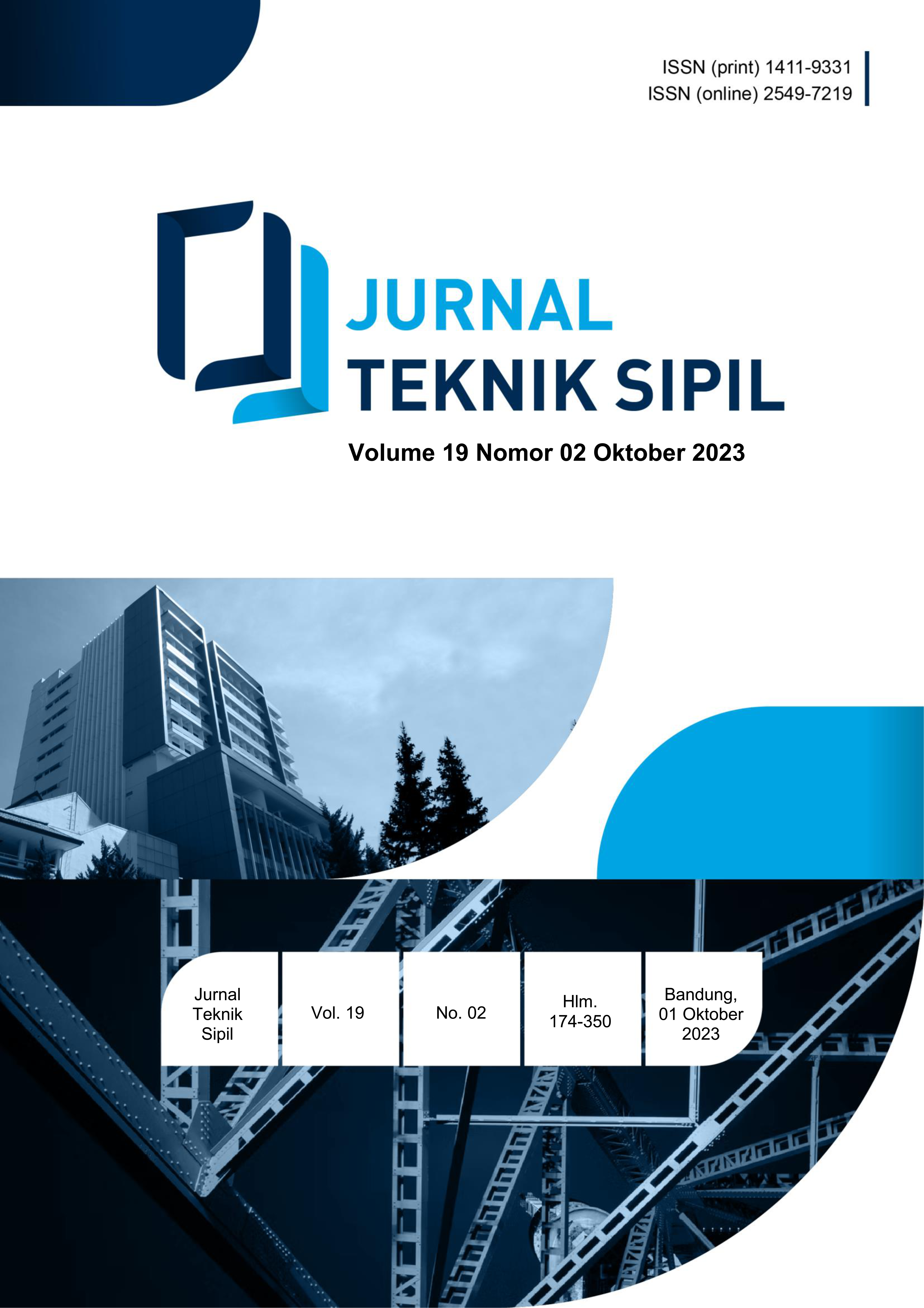Digitalization of The Construction Industry with BIM and 3D Machine Control Integration for Construction Performance Improvement.
DOI:
https://doi.org/10.28932/jts.v19i2.4497Keywords:
Building Information Modelling, 3D Machine Control, Efficiency, Toll RoadAbstract
The Government of the Republic of Indonesia through Presidential Regulation Number 100 of 2014 and Presidential Regulation Number 117 of 2015 aims the construction of the 2770 km Trans Sumatra Toll Road from Bakauheni to Banda Aceh to be fully constructed by 2024. There are two key stages in the project phase, i.e planning and construction stages. The planning stage is carried out using the Building Information Model (BIM), while the construction phase integrates BIM with 3D-Machine-Control. This study is conducted in Trans Sumatera Pekanbaru - Bangkinangs Toll Road with 40 kilometers long as a study case. The data acquisition methodology is conducted using qualitative and quantitative methods throughout the fields experiments. This study conducted the examination of the LiDAR UAV digital surveys accuracy, the BIM implementation on Level of Development (LOD) 200, 300, and 400, verification of the usage of Motor Grader with 3D-Machine-Control efficiency in elevation cutting works, and the application of Vibro Compactor with 3D-Machine-Control for improving the accuracy of soil compaction on the subgrade and base course. The results showed that the topographic data from UAV LiDAR are accurate within LE90 accuracy with 0.176 cm. The optimalization of 3D-Machine-Control could carry out the earthworks as similar as design also can be used as quality and quantity control. The time efficiency which obtained from implementing Motor Grader with 3D-Machine-Control for elevation cutting application is 47 percent.Downloads
References
Abidin, H. Z. (2000). Penentuan Posisi dengan GPS dan Aplikasinya. Pradnya Pramita.
Azar, E. R., & Kamat, V. R. (2017). Earthmoving equipment automation: A review of technical advances and future outlook. Journal of Information Technology in Construction, 22 December 2016), 247–265.
Building Information Modelling, (2019). http://sibima.pu.go.id/mod/page/view.php?id=3209.
Chong, H. Y., Lopez, R., Wang, J., Wang, X., & Zhao, Z. (2016). Comparative Analysis on the Adoption and Use of BIM in Road Infrastructure Projects. Journal of Management in Engineering, 32(6), 05016021. https://doi.org/10.1061/(asce)me.1943-5479.0000460
Darby, K. (2015). Preliminary Investigation Quantitative Cost-Benefit Analyses of the Use of Automated Machine Guidance in Construction: An Examination of Current Practice. http://www.dot.ca.gov/hq/construc/CPDirectives/cpd13-10.pdf
Ding, L., Wei, R., & Che, H. (2014). Development of a BIM-based automated construction system. Procedia Engineering, 85, 123–131. https://doi.org/10.1016/j.proeng.2014.10.536
Divisi Perencanaan Jalan Tol PT Hutama Karya (Persero). (2020). Exchange Information Requirements Jalan Tol Trans Sumatera. Author.
Heikkilä, R., Makkonen, T., Niskanen, I., Immonen, M., Hiltunen, M., Kolli, T., & Tyni, P. (2019). Development of an earthmoving machinery autonomous excavator development platform. Proceedings of the 36th International Symposium on Automation and Robotics in Construction, ISARC 2019, Isarc, 1005–1010. https://doi.org/10.22260/isarc2019/0134
Hersanto, F. W. (2010). Evaluasi Aplikasi GNSS CORS – RTK NTRIP untuk Pengukuran TDT (Titik Dasar Teknik) Orde 4.
Makkonen, T., Nevala, K., & Heikkilä, R. (2017). Automation of an Excavator Based on a 3D CAD Model and GPS Measurement. Proceedings of the 21st International Symposium on Automation and Robotics in Construction. https://doi.org/10.22260/isarc2004/0047.
Maleika, W. (2015). The influence of the grid resolution on the accuracy of the digital terrain model used in seabed modeling. Marine
Modul 6 Permodelan 3D, 4D, 5D, 6D, dan 7D Serta Simulasinya dan Level of Development (LOD), (2018).
Peraturan Pemerintah Republik Indonesia No. 15 Tahun 2005 tentang Jalan Tol, 1 (2005).
Position Partners Indonesia. (2020). Cara Lebih Baik Untuk Pekerjaan Tanah. Author
Rasul, A., Seo, J., & Khajepour, A. (2021). Development of integrative methodologies for effective excavation progress monitoring. Sensors (Switzerland), 21(2), 1–25. https://doi.org/10.3390/s21020364
Sugiyono. (2015). Metode Penelitian Kuantitatif, Kualitatif, dan R&D. CV. Alfabeta.
Tanoli, W. A., Seo, J. W., Sharafat, A., & Lee, S. S. (2018a). 3D Design Modeling Application in Machine Guidance System for Earthwork Operations. KSCE Journal of Civil Engineering, 22(12), 4779–4790. https://doi.org/10.1007/s12205-018-0309-y
Tanoli, W. A., Seo, J. W., Sharafat, A., & Lee, S. S. (2018b). 3D Design Modeling Application in Machine Guidance System for Earthwork Operations. KSCE Journal of Civil Engineering, 22(12), 4779–4790. https://doi.org/10.1007/s12205-018-0309-y
Townes, D. (2013). Automated Machine Guidance with Use of 3D Models– Executive Summary. Fhwa-Hq, 5
Vahdatikhaki, F., Hammad, A., & Siddiqui, H. (2015). Optimization-based excavator pose estimation using real-time location systems. Automation in Construction, 56, 76–92. https://doi.org/10.1016/j.autcon.2015.03.006
Vonderohe, A. P. (2007). Final Report Implementation of GPS Controlled Highway Construction Equipment University of Wisconsin – Madison.
Wehling, M. (2009). The Use of GPS and Machine Guidance SH 45 SE Turnpike-Austin, TX
White, D. J., Jahren, C. T., Vennapusa, P., Westort, C., Alhasan, A., Miller, D. K., Turkan, Y., Guo, F., Hannon, J., Dubree, A., & Sulbaran, T. (2018). Use of Automated Machine Guidance within the Transportation Industry. In Use of Automated Machine Guidance within the Transportation Industry. https://doi.org/10.17226/2508
Downloads
Published
How to Cite
Issue
Section
License
Copyright (c) 2023 Iwan Hermawan, Sutardi Sudirman

This work is licensed under a Creative Commons Attribution-NonCommercial 4.0 International License.















